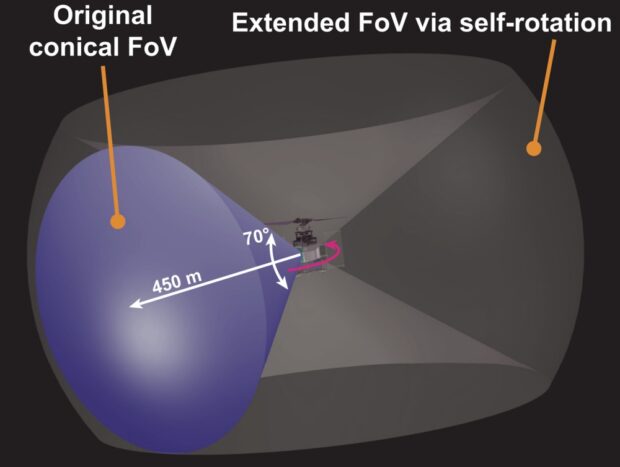Researchers in Hong Kong have published a paper demonstrating the utilization of self-rotation in UAVs to extend the sensor field of view (FoV) without consuming extra power.
Abstract
Uncrewed aerial vehicles (UAVs) rely heavily on visual sensors to perceive obstacles and explore environments. Current UAVs are limited in both perception capability and task efficiency because of a small sensor field of view (FoV).
One solution could be to leverage s to extend the sensor FoV without consuming extra power. This natural mechanism, induced by the counter-torque of the UAV motor, has rarely been exploited by existing autonomous UAVs because of the difficulties in design and control due to highly coupled and nonlinear dynamics and the challenges in navigation brought by the high-rate self-rotation.
Here, we present powered-flying ultra-underactuated LiDAR (light detection and ranging) sensing aerial robot (PULSAR), an agile and self-rotating UAV whose three-dimensional position is fully controlled by actuating only one motor to obtain the required thrust and moment. The use of a single actuator effectively reduces the energy loss in powered flights.
Consequently, PULSAR consumes 26.7% less power than the benchmarked quadrotor with the same total propeller disk area and avionic payloads while retaining a good level of agility. Augmented by an onboard LiDAR sensor, PULSAR can perform autonomous navigation in unknown environments and detect both static and dynamic obstacles in panoramic views without any external instruments.
We report the experiments of PULSAR in environment exploration and multidirectional dynamic obstacle avoidance with the extended FoV via self-rotation, which could lead to increased perception capability, task efficiency, and flight safety.
Acknowledgments
We would like to thank Y. Ren and G. Lu for help with the mechanical design and helpful discussions.
Funding: This work was supported by the Hong Kong Research Grants Council (RGC) General Research Fund (GRF) (no. 17206920), the Hong Kong Research Grants Council (RGC) Early Career Scheme (ECS) (no. 27202219), and a DJI research donation.
Author contributions: N.C. and W.X. proposed the initial idea of the research. N.C. designed and manufactured the UAV prototype, formulated the dynamic model with F.Z., and implemented all software modules for the UAV with the help of F.K., W.X., and Y.C. The experiments were designed by N.C. and performed by N.C., F.K., W.X., Y.C., D.H., and Y.Q. N.C. and H.L. contributed to the data acquisition on a test stand. N.C. finished all data analyses. N.C. and F.Z. wrote the manuscript with the advice of all authors. F.Z. provided funding and supervised the research.
Competing interests: The authors declare that they have no competing interests.
Data and materials availability: All data needed to evaluate the conclusions in the paper are present in the paper or the Supplementary Materials and in an online database (60).
Source: ScienceRobotics

